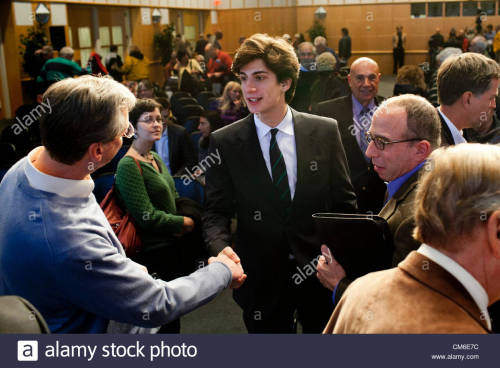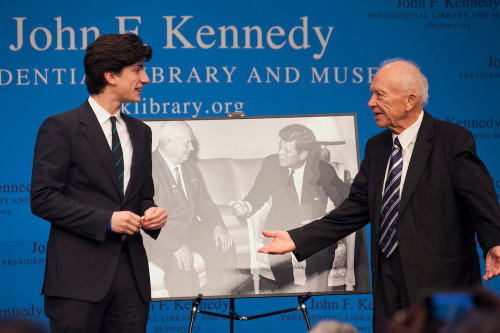#jfklibrary

(AR8035-C)
Did you know JFK had a formal White House visit with a troll? It’s true! Pictured, President Kennedy meets pilot Betty Miller (who completed the first solo flight by a woman across the Pacific Ocean) and “Dammit,“ the troll doll who joined her for the trip!
Betty Miller was a helicopter and plane pilot who ran a flight school with her husband in Santa Monica, California. In 1963, she became the first woman to fly solo across the Pacific Ocean, flying from California to Australia. In total, she flew 7,415 miles, which took over 51 hours of flight time to complete.
Two months after her flight, she received the FAA’s Decoration for Exceptional Service, and showed JFK and FAA Administrator Najeeb Halaby the route of her flight.
Starting this month, in conjunction with the YWCA’s national program, Stand Against Racism, the JFK Library will share stories of people who took a stand against racism during the Kennedy administration.

Martin Luther King Jr., head of the Southern Christian Leadership Conference, calls Birmingham, Alabama “the worst big city in race relations in the United States.” He writes this on December 17, 1962 in a telegram to President Kennedy after the bombing of Birmingham’s Bethel Church. This is just one in over fifty bombings in fifteen years, in a city that has segregation written in its laws and a police department.
A major demonstration in Birmingham could bring a much-needed victory for the civil rights movement. King works with Wyatt Tee Walker, Ralph Abernathy, Fred Shuttlesworth and other SCLC leaders to devise a plan. They call it Project C - ‘c’ for confrontation.
Starting on April 3, 1963, it will build in waves, first with sit-ins, then a boycott, and finally, non-violent protest marches on a daily basis, which are likely to provoke heavy-handed reactions from police, with mass arrests. The media will cover it, and everyone will see why black people are asking for justice in the South.
This past month, the Archives division at the JFK Library welcomed six volunteer library science graduate students as part of Preservation Week. We sat down with Archivist & Oral History Coordinator Jennifer Marciello to talk about their work and what they discovered.
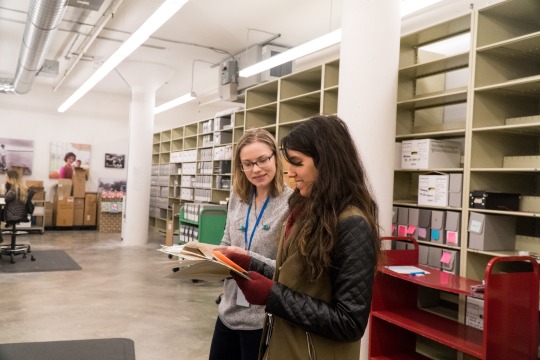
How did Preservation Week come about?
In the Archives Division here at the Library, we have a Preservation Subcommittee whose focus is to identify and document any preservation concerns in our historic collections and come up with plans to address them. In doing this, we noticed that there were some very sizable collections with issues that needed to be addressed, but were too large for any one staff member to take on.
This is where the idea for Preservation Week came from. Instead of one staff member devoting weeks, months or, in some cases, years to one project, we devised a program that would get archival staff and interns involved in working on a specified project for one week out of each semester – three times a year – with the goal of completing the preservation tasks. This program has a dual benefit of allowing interns the opportunity to work and collaborate on a larger shared project, while at the same time completing necessary preservation tasks that do not normally fit into current workflows.
This time, along with some of our archival staff and paid interns, we had the help of Alternative Spring Break volunteers, which is a program that NARA (National Archives and Record Administration) coordinates to provide students with an opportunity to work at a NARA facility. This year, our volunteers were from the Library and Information Science Graduate Programs at Simmons College in Boston, and at Wayne State University in Detroit.
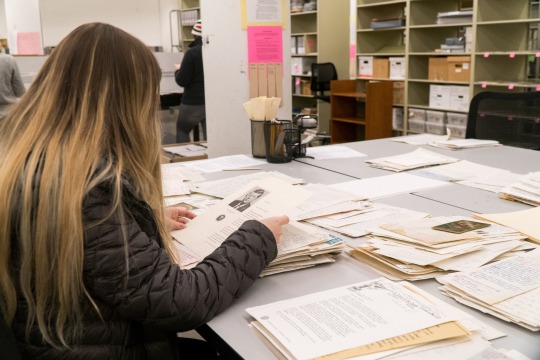
What was the collection you worked on for this Preservation Week?
For this Preservation Week, we worked on the John F. Kennedy Condolence Mail Collection. This is the mail received by the White House and Mrs. Kennedy after President Kennedy’s assassination, and reflects the world-wide reaction to the death of President Kennedy. Previously, it had been minimally processed, which meant that many boxes were still inaccessible to researchers, and there were some significant preservation issues that needed to be addressed.
How large is the collection?
When we started, the collection was roughly 200 cubic feet. This past Preservation Week, we were able to reorganize 120 boxes of mail (60 cubic feet) – specifically the letters D through P. Since we began the program as a whole, we’ve reorganized and made accessible over 160 boxes (80 cubic feet of material) – the letters A through P. We have about two more rounds of Preservation Week to finish out the alphabet. By the Fall, we’re hoping to have all of the domestic letters in the collection – letters sent from the US – sorted, alphabetized, preserved and accessible to researchers.
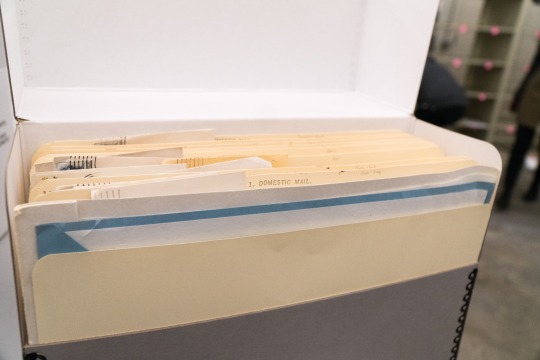
When you were sorting the letters, did you come across anything surprising or especially notable?
I think the takeaway from the project for many of the volunteers who worked with it was the overall outpouring of grief as well as the personal nature of many of the letters, people relating personal stories, offering prayers, aid or asking for help. The majority of the writers discussed their love of the President, and the sadness and grief that they as American citizens felt. Many of the volunteers who worked on this project mentioned that they wouldn’t think of writing to the President or First Lady in this capacity, or feel as personally connected to a politician or political family in this day and age.
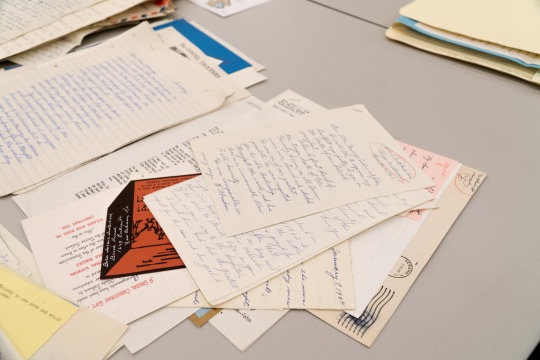
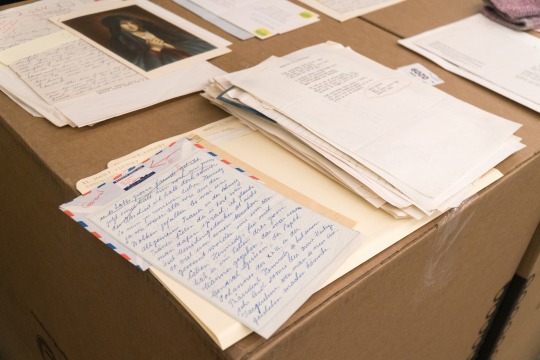
What’s the importance of processing this collection?
Over the years, we’ve found that most of the requests we get to access this collection are from individuals looking for the letters that either they sent or that their family members sent to Mrs. Kennedy. The collection was originally sorted by type – for example, letters with Mass cards, or poems, or drawings, or written by children. We found that with the reference requests we were getting, most people remembered they wrote a letter, but they didn’t remember specifically if they sent a mass card, or wrote a poem, etc. So by reorganizing the collection alphabetically by last name of the individual, Library staff can easily search through a few boxes instead of 200 cubic feet of material. It’s a huge accomplishment and will be of immense help in helping the public find their letters!
Jack at a ceremony at the JKF library to honour the 50th anniversary of the Cuban Missile crisis
Post link

Civil rights crusader Fannie Lou Hamer represents the Mississippi Freedom Democratic Party. Methodist Church Ministries/Kenneth Thompson, online here.

“NOBODY’S FREE UNTIL EVERYBODY’S FREE.”
In honor of Women’s History Month (March) and Black History Month (Feb), we continue our celebration of Black women with this special virtual Kennedy Library Forum on March 16 at 7 pm ET. Registerhereto watch live or later.
Kate Clifford Larson, visiting scholar at the Brandeis Women’s Studies Research Center, will discuss her new book with Karsonya (Kaye) Wise Whitehead, professor of communication and African and African American studies at Loyola University Maryland.
Walk with Me: A Biography of Fannie Lou Hamerdraws on new interviews and fresh archival material to explore Hamer’s life and impact on the civil rights movement. Kennedy Library education and public programs on civil rights and social justice are supported in part by AT&T.

Archives specialist Netisha Currie wrote about Hamer for the National Archives Say It Loud! Employee Affinity Group’s Rediscovering Black Historyblog’sBlack History Basic Training series.Currie shared Hamer’s incredible history that included African American voter registration, organizing Freedom Summer, co-founding the Mississippi Freedom Democratic Party, and helping to establish the National Women’s Political Caucus in 1971.

Governor Bill Clinton’s “Vision for America” speech at the Democratic National Committee (DNC), 7/16/1992, Clinton Library, NARA ID 18557458.
FOR KIDS AND EDUCATORS:
- DocsTeach: Fannie Lou Hamer and Voting Rights: Students will analyze a portion of Hamer’s testimony at the 1964 Democratic National Convention about registering to vote in Mississippi in 1962. They will answer questions to understand the specific challenges Black Americans faced, and the motivations behind the Civil Rights Movement.
- Meet Fannie Lou Hamer:National Archives Comes Alive! Young Learners Program. Online here.Hamer (as portrayed by Sheila Arnold) shared her story from her birth as the 20th child of parents who were tenant farmers in Mississippi to her efforts to organize the Mississippi Freedom Summer for the Student Nonviolent Coordinating Committee (SNCC) and more.


